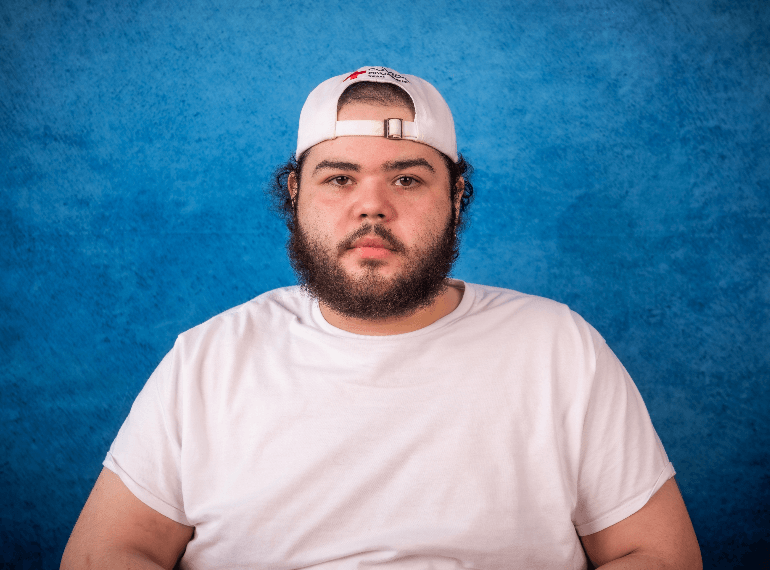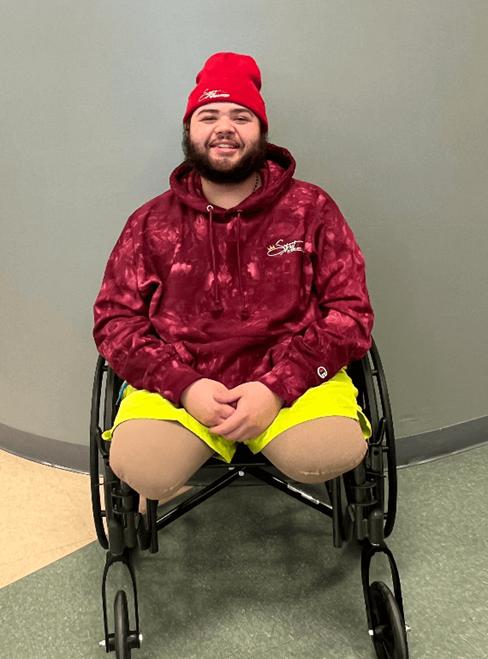Santos' Story

Amputation

Santos Perez loved cars. “I love to drive my car - an Infinity Q50,” said Santos. “I like to modify it and work on the car and soup it up...I like to go to car meets.”
Not surprisingly, the 23-year-old made his living by driving a vehicle. As a FedEx driver, one day he went to work where he was training a new driver to take over his route. After loading the cargo at a stop with a loading dock, the new driver moved the truck forward so Santos could close up the back. However, the truck was mistakenly left in reverse instead of park.
As a result, the truck rolled backward and pinned Santos to the loading dock, crushing his legs. “It’s crazy because I didn’t feel it, but I heard my legs crunch,” he recalled. “It sounded like when you step on crunchy leaves.”
Santos remained trapped for about 10 seconds, pounding on the truck to get the driver's attention. Eventually, the driver realized what had happened and moved the truck forward. Santos slowly lowered himself to the ground and asked for an ambulance, as it seemed everyone around was in shock.
At John Peter Smith Hospital, doctors used a CAT scan to assess Santos's injuries. Despite surgery to pin his legs back together with external fixators, the damage was too severe, and blood flow to the injured areas never returned. Santos had to undergo a right above-knee amputation and a left below-knee amputation. A month later, he had further surgery to amputate both legs higher above the knee.
Santos faced significant physical challenges due to his new condition. He chose to go to Baylor Scott & White Institute for Rehabilitation (BSWIR) – Fort Worth for treatment. He remembered, "They said it was a younger environment, so I wanted to come here." The physician-led therapy team at BSWIR – Fort Worth designed a treatment plan to help Santos adapt to his amputations and regain independence.
In physical therapy, Santos focused on strengthening his upper body and his balance. “I like doing the core exercises and learning to find my balance,” he said. “I liked playing ping pong and I like going on the outing, too.” His occupational therapist worked with him to retrain his activities of daily living like getting dressed and bathing.
Experiencing trauma like Santos did can leave emotional scars. Talking to someone who has been through a similar experience can provide comfort. “They arranged for a mentor to come up that was also a double amputee to talk to me,” Santos said. “It really helped me when I got to see his prosthetics and see that there was hope and a future for me.” His family has also helped support and encourage him during therapy. “They’ve been a great support system,” he said.
With a positive attitude and dedication to his treatment plan, Santos began to witness progress as he gained strength and balance. Removing his sutures marked a turning point in his recovery. “Once I got the sutures out, I knew I was healed and could start doing more things with my legs. Before I got them out, there was always the thought or doubt that they wouldn’t heal or I would need more surgeries,” he said.
His newfound confidence pushed Santos to keep up the hard work and continue making progress. “I feel like I’m definitely self-sufficient,” he said. “I really had to get over the mental block and being scared of doing stuff.”
As he prepared to transition out of inpatient rehabilitation, Santos looked forward to getting home and “getting back into my life and being able to do more.” When asked about his experience at BSWIR – Fort Worth, he replied, “It was great. I really like the environment. The therapists are so much fun.”
Santos offered advice to those facing a similar situation: “Keep a positive attitude,” he said. “When this happened, I knew I couldn’t change it, all I could do was move forward and do the best I could.”
“I really learned how strong I am,” he said.